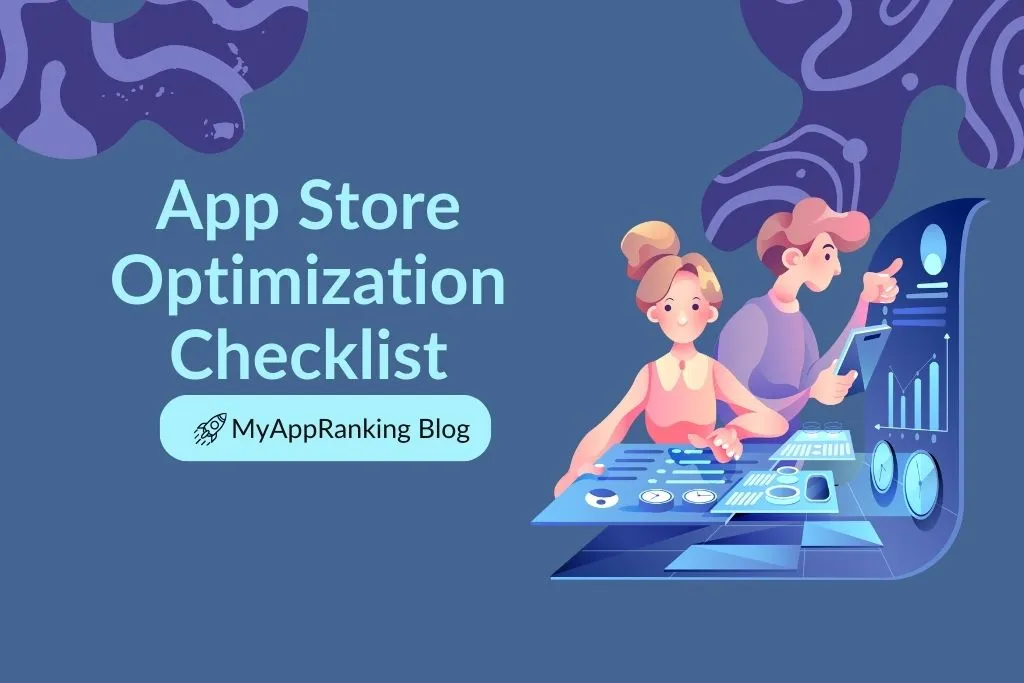ASO Checklist: Optimizing Your App for Success

In today’s digital age, having a stellar app isn’t enough; it needs to be discovered among millions of others in the app stores. That’s where App Store Optimization (ASO) comes into play. ASO is the process of improving an app’s visibility in app stores by optimizing various elements. Whether you’re a seasoned app developer or just starting out, having a comprehensive ASO checklist is crucial for maximizing your app’s success. In this blog post, we’ll delve into the essential elements of an ASO checklist and provide examples to guide you through each step.
1): Create an Effective Keyword Research:
Keywords are the foundation of ASO. Start by brainstorming relevant keywords that users might use to search for your app. Utilize tools like Google Keyword Planner, App Annie, or Sensor Tower to identify popular and relevant keywords in your niche. For instance, if you’ve developed a fitness app, keywords like “workout planner,” “fitness tracker,” and “exercise routines” would be pertinent.
App Store:
Utilize relevant keywords in your app’s metadata, including the title, subtitle (iOS), short description (Google Play), and long description. Focus on including keywords that are highly searched and relevant to your app’s functionality.
- Character Requirements:
- App Store (iOS): The app title can have up to 30 characters, while the subtitle allows up to 30 characters. The long description can contain up to 4,000 characters.
- Play Store (Android): The app title can have up to 50 characters, and the short description allows up to 80 characters. The long description can contain up to 4,000 characters.
2): Choose the Right App Title:
Your app title is one of the most crucial elements for ASO. It should be catchy, memorable, and include relevant keywords. Take, for example, the app “Headspace: Meditation & Sleep.” It communicates the app’s purpose while incorporating keywords related to meditation and sleep, enhancing its discoverability.
App Store:
Ensure your app title is concise and descriptive, incorporating primary keywords while maintaining readability. Apple allows up to 30 characters for the app title.
Play Store:
Optimize your app title by including primary keywords and conveying the app’s purpose clearly. Google allows up to 50 characters for the app title.
3): Use Keywords in Subtitle and Short Description:
The subtitle and short description are prime real estate for including additional keywords. Use these sections to reinforce your app’s main features and benefits while incorporating relevant keywords. Take inspiration from “Spotify,” which includes keywords like “music streaming” and “playlist maker” in its subtitle and short description to improve discoverability.
App Store:
Incorporate relevant keywords into your app’s subtitle to enhance visibility in search results. Use the short description to provide additional context and reinforce key selling points using targeted keywords.
Play Store:
Optimize your app’s short description with relevant keywords to improve visibility and attract more users. Use the subtitle to highlight key features and benefits while incorporating additional keywords to improve discoverability.
4): Optimize Your Keyword List (Apple):
When we talk about optimizing your keyword list in the context of Apple’s App Store, we’re referring to the process of selecting and strategically using keywords in your app’s metadata to improve its discoverability in search results.
In the App Store, developers have the opportunity to input a list of keywords that are relevant to their app. These keywords should accurately represent the app’s features, functionalities, and purpose. The goal is to choose keywords that potential users are likely to search for when looking for an app like yours.
Here’s how to optimize your keyword list effectively:
- Research Relevant Keywords: Use tools like the App Store Connect Keyword Research tool or third-party ASO tools to identify relevant keywords related to your app’s niche, features, and target audience.
- Prioritize High-Volume and Relevant Keywords: Focus on including keywords with high search volume and relevance to your app. Avoid generic or overly competitive keywords that may be challenging to rank for.
- Experiment with Different Variations: Test different combinations of keywords to see which ones perform best. Consider using variations, synonyms, and long-tail keywords to cover a broader range of search queries.
- Update Regularly: Keep an eye on keyword trends and user behavior to adapt your keyword list accordingly. Regularly update and refine your keyword list based on performance data and changes in the app store landscape.
- Stay within Character Limit: The total character limit for your keyword list is 100 characters. Make sure to use this space wisely by prioritizing the most relevant and high-performing keywords.
By optimizing your keyword list in the App Store, you can increase your app’s visibility and improve its chances of being discovered by potential users who are searching for apps like yours.
5): Write a comprehensive App Description:
Craft a compelling app description that accurately portrays your app’s features and benefits. Incorporate relevant keywords naturally within the description to improve search visibility. Take inspiration from the description of “Duolingo: Learn Languages Free,” which succinctly highlights the app’s features while including keywords like “learn languages” and “language learning.”
App Store:
Write a concise and engaging app description that highlights key features, benefits, and use cases. Apple allows up to 4,000 characters for the app description.
Play Store:
Create a compelling app description that communicates the app’s value proposition and includes relevant keywords. Google allows up to 4,000 characters for a long description.
6): App Icon:
The app icon is the first thing users see, so it needs to make a strong impression. Design an icon that reflects your brand identity and stands out among competitors. Consider the iconic green logo of the “WhatsApp” messenger app, instantly recognizable and associated with messaging.
App Store:
Design your app icon to be visually appealing and easily recognizable, even at smaller sizes. Apple recommends using a simple design with a unique shape and limited colors.
Play Store:
Create an app icon that follows Google’s design guidelines and stands out on various devices and backgrounds. Ensure your app icon is visually appealing and represents your brand effectively.
7): App Screenshots and Videos:
Visuals play a significant role in attracting users. Use high-quality screenshots and videos to showcase your app’s interface, functionality, and key features. For example, the screenshots for “Instagram” effectively showcase the app’s photo-sharing capabilities and user interface, enticing potential users to download it.
App Store:
Create engaging screenshots that highlight the app’s features and benefits. Apple allows up to 10 screenshots per app, supporting both iPhone and iPad sizes.
Play Store:
Utilize engaging screenshots and videos to showcase your app’s features and functionality. Google allows up to 8 screenshots and 3 videos per app listing.
8): App Ratings and Reviews:
Positive ratings and reviews are crucial for building trust and credibility. Encourage satisfied users to leave reviews and respond promptly to any negative feedback to demonstrate your commitment to improving the app. “Uber,” for instance, actively solicits feedback from users and responds to reviews to maintain a positive reputation.
App Store:
Encourage users to leave ratings and reviews by prompting them within the app. Respond to user feedback promptly and courteously to show your commitment to user satisfaction.
Play Store:
Prompt users to leave ratings and reviews through in-app prompts. Respond to user reviews and address any concerns or issues raised by users to improve overall app ratings and reputation.
9): App Updates:
Regular updates demonstrate your dedication to improving the app and addressing user feedback. Keep users engaged by introducing new features, fixing bugs, and optimizing performance with each update. “Netflix” consistently updates its app with new content and features, keeping users coming back for more.
App Store:
Regularly update your app to introduce new features, fix bugs, and improve performance. Utilize release notes to communicate changes and improvements to users.
Play Store:
Keep your app updated with new features and bug fixes to enhance user experience. Provide detailed release notes to inform users about changes and improvements in each update.
10): Localization:
Consider localizing your app for different regions and languages to reach a broader audience. Translate your app’s keywords, description, and content to resonate with local users. “PUBG Mobile” effectively localized its app for various regions, adapting to cultural preferences and languages to enhance user experience worldwide.
App Store:
Localize your app’s metadata, including the title, description, and keywords, to target specific regions and languages effectively. Tailor your app content and marketing materials to resonate with local audiences.
Play Store:
Translate your app’s title, description, and keywords into different languages to improve discoverability and appeal to international users. Adapt your app’s content and visuals to suit the preferences and cultural norms of different regions.
11): App Category and Subcategory:
Choose the most relevant category and subcategory for your app to ensure it appears in relevant search results and browsing sections. For instance, if you’ve developed a puzzle game, categorize it under “Games” and further specify the subcategory as “Puzzle.”
App Store:
Select the most appropriate primary and secondary categories for your app to improve discoverability and visibility in search results and category rankings.
Play Store:
Choose the most relevant category and subcategory for your app to enhance discoverability and ensure it appears in relevant browsing sections and search results.
12): Study Your Competitors:
Analyze your competitors’ apps to understand their ASO strategies. Identify their keywords, app titles, descriptions, and visuals. Learn from their successes and failures to refine your own ASO strategy. For example, if you’re developing a weather app, study how competitors like “The Weather Channel” optimize their app listings for maximum visibility.
App Store:
Use tools like App Annie or Sensor Tower to analyze competitor apps and identify keywords, titles, and descriptions that contribute to their success. Study their app listings and user reviews to gain insights into their ASO strategies.
Play Store:
Utilize tools like Google Play Console or Mobile Action to analyze competitor apps and identify effective ASO strategies. Pay attention to their app titles, descriptions, and visuals, and use this information to refine your own ASO approach.
13): Perform A/B Testing:
Conduct A/B testing to compare different elements of your app listing, such as titles, icons, descriptions, and screenshots. Gather data on user engagement and conversion rates to determine which variations perform best. For instance, “Clash of Clans” might A/B test different app icons to see which one generates more downloads and user retention.
App Store:
Use A/B testing tools like StoreMaven or SplitMetrics to experiment with different app elements and measure their impact on conversion rates and user engagement. Test variations of your app title, icon, screenshots, and descriptions to optimize your app listing for maximum effectiveness.
Play Store:
Use Google Play Experiments to conduct A/B tests on different app elements and measure their impact on conversion rates and user engagement. Test variations of your app title, icon, screenshots, and descriptions to identify the most effective combination for driving downloads and installs.
Final Thoughts:
In conclusion, optimizing your app for the app stores is a multifaceted process that requires careful attention to various elements. By following this comprehensive ASO checklist and implementing best practices tailored to the App Store and Play Store guidelines, you can enhance your app’s visibility, attract more users, and ultimately achieve success in the competitive app market. Remember, ASO is an ongoing process, so continuously monitor and adjust your strategy to stay relevant and maximize results.
Do you Want
More App Downloads?
Boost the Mobile App Growth with the Ultimate Mobile App Marketing Experts
Latest Blogs
Categories
Do you Want
More App Downloads?
Boost the Mobile App Growth with the Ultimate Mobile App Marketing Experts
ASO Checklist is a comprehensive guide that outlines the essential steps and strategies for optimizing an app’s visibility and performance in the app stores. It covers various elements such as keyword research, app title, icon design, app description, and more to enhance an app’s discoverability and attract more users.
ASO Checklist is crucial for app developers because it helps them improve their app’s visibility and ranking in app store search results. By following the checklist, developers can ensure that their apps are effectively optimized to attract more organic traffic, increase downloads, and ultimately achieve success in the competitive app market.
To optimize your app using ASO Checklist, start by conducting thorough keyword research to identify relevant keywords for your app. Then, optimize your app title, icon, description, and other metadata elements with these keywords. Additionally, focus on creating high-quality screenshots, videos, and obtaining positive ratings and reviews to improve user engagement and credibility.
Yes, ASO Checklist is applicable to both the App Store (for iOS apps) and Google Play Store (for Android apps). While some elements may vary slightly between the two platforms, the fundamental principles of ASO remain the same. Whether you’re optimizing your app for the App Store or Google Play Store, following the checklist can help improve your app’s visibility and performance.
ASO Checklist is an ongoing process that requires continuous monitoring and optimization. App store algorithms and user behaviors constantly evolve, so it’s essential to regularly review and update your ASO strategy. Keep track of changes in keyword trends, competitor strategies, and app store guidelines to stay ahead and maintain your app’s visibility and success.




